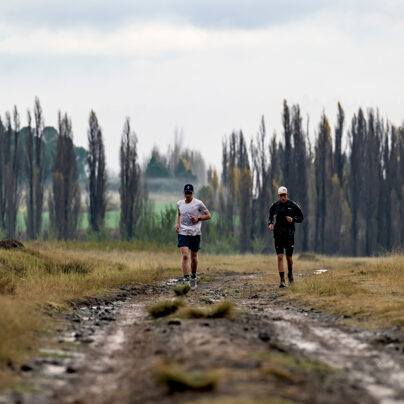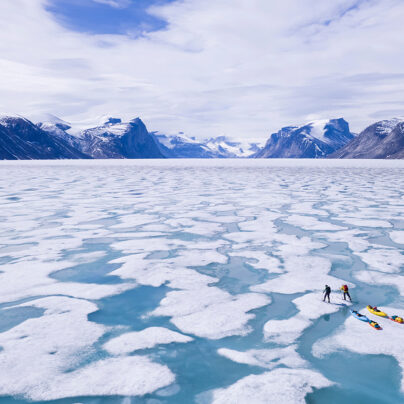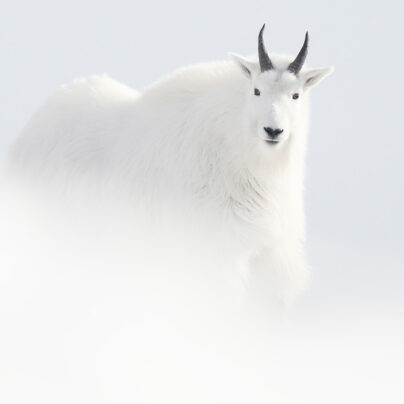The Yukon Quest
Ariel Body
“It’s coming down to a matter of seconds” are not the words I was expecting to hear at the finish line of a 1,000 mile sled dog race, and yet that’s what was blared over the speakers as we watched two headlamps bob up and down and grow closer.
Nearly two weeks earlier I had stepped off the plane and experienced my first glimpse of the incredible beauty of the north. I was in Alaska, in the dead of winter. Each breath left a tiny layer of frost on my eyelashes, and I could feel the inside of my nostrils freeze within seconds of walking outside. It was slippery and frigid, and I was stoked; and the real adventure hadn’t even begun.
In Fairbanks, I met up with two other photographers and a video editor to embark on an adventure of our own: following the Yukon Quest – also aptly known as the ‘World’s Toughest Sled Dog Race’ – to document and tell the visual story of the incredible journey.
To put it simply, the Yukon Quest is a sled dog race where mushers, with their teams of up fourteen dogs, embark on a 1,000 mile journey from Fairbanks, Alaska (US) to Whitehorse, Yukon (Canada). They carry all the supplies they need for the duration of the race in their sled. The 2012 race marked the 24th running of the historic event, and a diverse group of twenty-three mushers had travelled from around the world to compete.
As a photographer and videographer for the official media team, I would be following the mushers along the trail, experiencing the same checkpoints and laying eyes on some of the same terrain in an attempt to fully tell the story of the extreme and unique race.
If I’m honest, prior to the start I had no idea what to expect; I knew next to nothing about mushing, and hailing from the deserts of Arizona, was slightly terrified of the impending, and potentially crazy, sub-arctic weather. In my head, I had embraced the cliché that all sled dogs were fluffy Siberian Husky types, with their bright blue eyes and adorably fluffy coats. In reality, the ‘typical’ racing sled dog weighed in around forty pounds, barely came past my knee, and looked like an ‘everyday’ dog. Though small as they may seem, don’t let their size fool you: sled dogs are pretty hardcore. Essentially elite athletes of the canine world, they’re made up of sheer muscle and enthusiasm. At any sign of running, the dogs were jumping in their harnesses to get on the trail, and the myth of the abused and overworked sled dog was nowhere to be found.
It was a frisky -20F at the start line in Fairbanks, as the mushers arrived throughout the morning, feeding and prepping their teams for the oncoming trek. With twenty-three teams arriving in the pre-race staging area, there was a real sense of excitement about. With handlers and mushers making last minute adjustments, there were perky dog-ears and ice beards pretty much everywhere you looked.
Nearly two weeks earlier I had stepped off the plane and experienced my first glimpse of the incredible beauty of the north. I was in Alaska, in the dead of winter. Each breath left a tiny layer of frost on my eyelashes, and I could feel the inside of my nostrils freeze within seconds of walking outside. It was slippery and frigid, and I was stoked; and the real adventure hadn’t even begun.
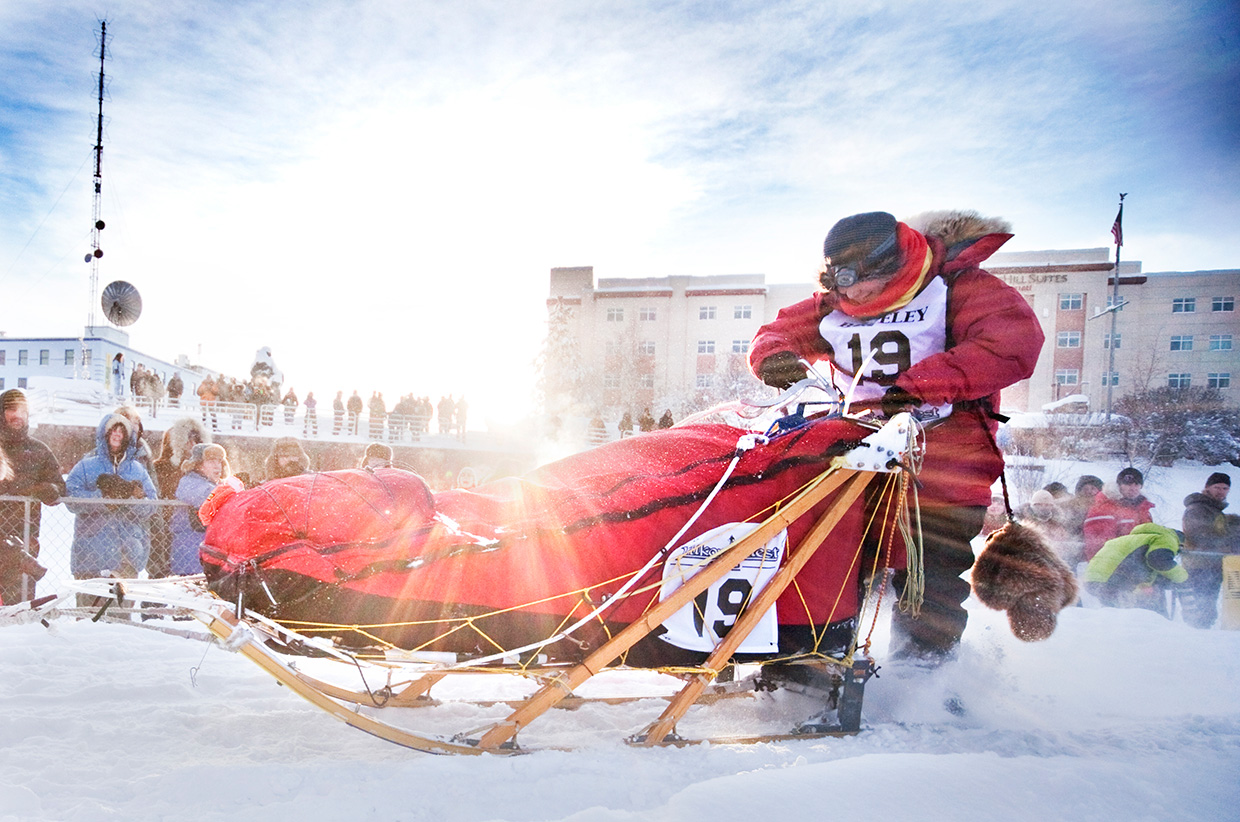
And then there was me. Eyes-wide, perched in a snow-bank on the edge of the start chute, camera in hand, ready to shoot. My fellow team-members were strapping GoPro cameras to anything they could find and gearing up to capture the official start from their own individual perspectives. The energy of the start was contagious, as fans suited up in puffy layers of warmth and lined the river as far as I could see to enthusiastically cheer on their favourite mushers and sled dogs.
Three, two, one… Before I knew it, the first musher, Allen Moore, was off.
I quickly realized just how fast sled dogs ran. The winter gear I was wearing? Not so helpful in the agility department. My size-too-big boots, giant red Canada Goose jacket, and super-stiff (but regionally trendy) Carhartt bibs made each movement a challenge. My hair slowly turned white from frost and my battery drained twice as fast as usual, but it had officially begun – I was actually about to follow some hardcore mushers 1,000 miles through the wilderness. What a rush!
One-by-one the teams were led down to the start chute on the Yukon river, where the cheers from the crowd mixed with the howls of the dogs as each team bolted down the trail into the setting sun, officially beginning their adventure on the Yukon Quest.
That night, we travelled to the second checkpoint 101 miles down the trail. A tiny cluster of cabins just off the Yukon River in the middle of some Alaskan mountains, I sat out waiting to shoot the arrival of the first musher. That’s when I was first greeted by the vivid green dancing of the Northern Lights overhead. Complemented by the brightest stars and constant howls of ecstatic sled dogs, to say it was a surreal moment is an understatement.
Mushers arrived throughout the night, many stopping to grab a couple hours of sleep in the tiny wood-heated cabin while others chose to continue on and camp on their own in the silent darkness. Over the next few days, mushers would adopt bizarre sleeping patterns, strategically alternating between running and resting. Each musher had their own strategy and a running schedule highly dependent on weather patterns, especially in regards to crossing the four major summits along the trail. The infamous Rosebud and Eagle summits, each towering over 1,000 meters high, awaited the mushers just after Mile101. For the most part, the infamously rough summits offered clear weather and easy passing, avoiding a repeat of nightmare rescues from years passed.
Several hundred kilometers on, Dawson City marked the midway point. IT was the first checkpoint on the Yukon side of the Quest, carrying with it a much-welcomed 36-hour mandatory rest for the teams. A snow covered town that boomed in the gold mining rush of the 1800s, Dawson is beautifully positioned on the Yukon River, where strolling down the street past the notorious grounded steamboat and quaint shops with names like ‘Diamond Toothed Gerties’ or the ever popular ‘Drunken Goat Tavern’ is enough to convince you that you’ve been transported straight back to the roaring 1850’s.
One-by-one the teams were led down to the start chute on the Yukon river, where the cheers from the crowd mixed with the howls of the dogs as each team bolted down the trail into the setting sun, officially beginning their adventure on the Yukon Quest.
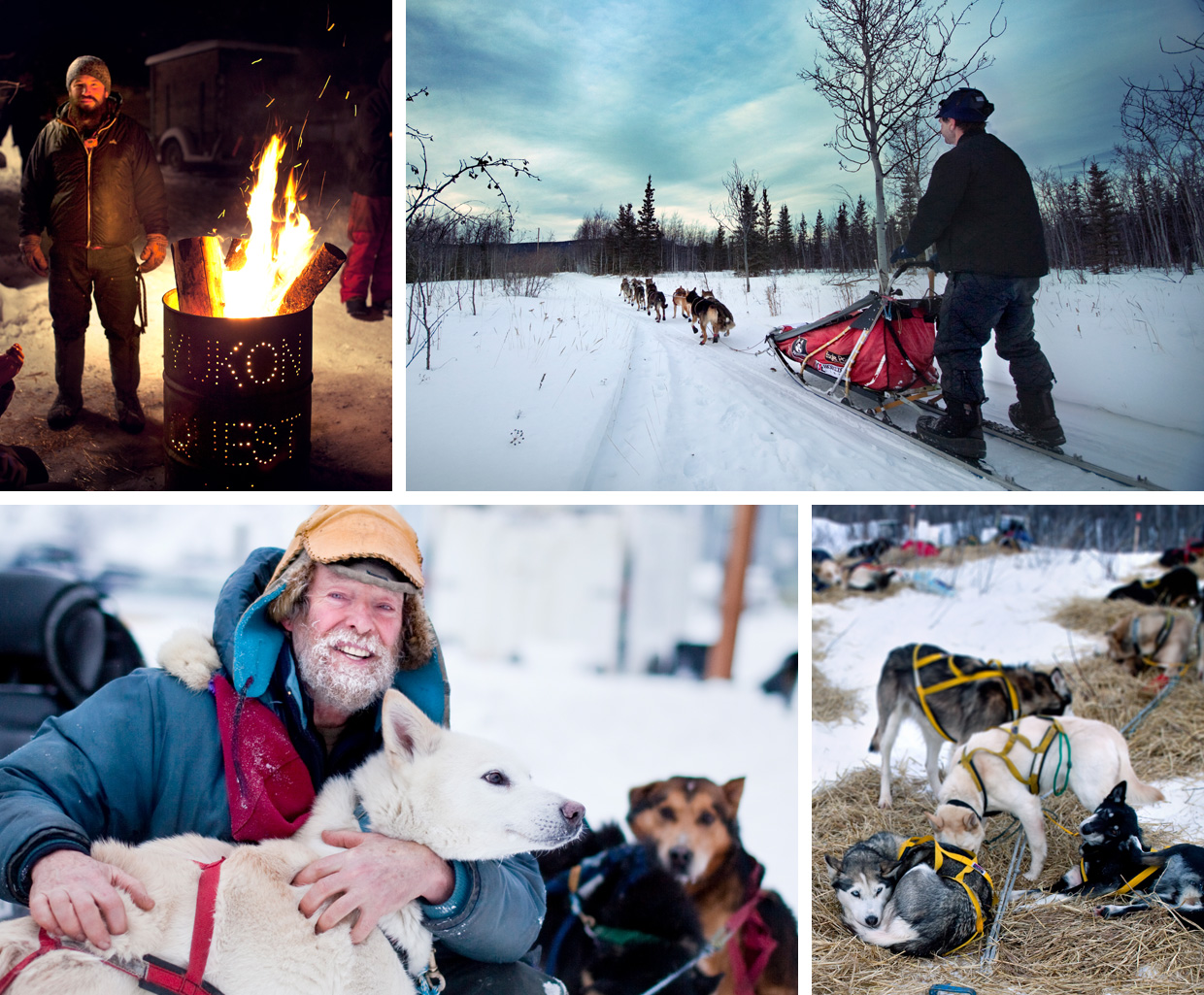
Allen Moore, long-time Quest runner, was first to pull into Dawson City, earning him the four ounces of Dawson gold that was customary for the first musher to cross the half-way mark. Trickling in over the next few days, the remaining mushers slid across the halfway point, telling stories from the trail so far – of beautiful Northern Light displays, near-misses, and sleep deprivation causing hallucinations. Hearing everything from imagining giant red toasters in the middle of a field to yelling at a fence post after mistaking it for a moose, it was clear that exhaustion was starting to set in for the mushers.
We were in Dawson City for quite a few days, using it a base to venture up and down the river, taking advantage of the majestically snow-covered mountains and getting a closer glimpse at some of the trail conditions the mushers were experiencing. The weather got consistently warmer as we went, causing the river to thaw quicker than usual, and making running conditions more difficult for dogs used to below-freezing temps.
Dawson City also saw my first attempt at mushing. Yelling “gee” and “haw” as we sped over the bumpy trail – the same trail that Quest runners arrived and departed on – was exhilarating. Harvey, my mushing mentor, and I attempted to tackle a semi-steep (but still tiny) hill and ended up face-planting in the snow. Both laughing, he assured me that it was “all part of the experience!”
Between shooting mushers coming and going, I’m pretty sure we proceeded to eat every variation of moose dish during our time there, and I also learned a valuable lesson about below-freezing temps and their ability to flash-freeze wet hair. Dawson was good – a nice rest – but the race was far from over.
From Dawson, we chased the teams on down the quickly-thawing Yukon River, driving for miles past an array of Yukon wildlife and breathtaking mountainscapes. We then geared up and trekked with the snowmobiles to the more remote Stepping Stone stop. A homely atmosphere, with hand-written signs like “Hungry yet? 400m” and “Burritos, 300m” welcoming mushers on the trail, it was a musher favourite.
With a couple hours to spare before the first musher was due to arrive, I walked out on the frozen river and let myself fall backwards into the snow. It was dark, but the sky was filled with the brightest stars I’d ever seen which were chased, but barely-dimmed, by a glowing full moon. I could only imagine what it was like for the mushers out on the trail – just them and their dogs, doing what they loved, surrounded by the extreme Yukon wilderness.
At this point, the last of the four major summits had been conquered, but the trail was still, by no means, smooth sailing. Leaning over a bridge at McCabe Creek the following day, I watched two teams cross the quickly thawing frozen water. The dogs’ paws waded through at least two inches of overflow, demonstrating just how slippery navigating the trail was in light of the unusually warm weather.
With a couple hours to spare before the first musher was due to arrive, I walked out on the frozen river and let myself fall backwards into the snow. It was dark, but the sky was filled with the brightest stars I’d ever seen which were chased, but barely-dimmed, by a glowing full moon. I could only imagine what it was like for the mushers out on the trail – just them and their dogs, doing what they loved, surrounded by the extreme Alaskan wilderness.

Between constantly trekking the trail, editing and uploading photos along the way, and crashing in a sleeping bag in the back of checkpoints whenever we had a few hours to spare, I was exhausted. I could only imagine what the mushers were feeling after what they’d been through, but with such a close margin they couldn’t afford to let the side effects of the gruelling race get to them.
The final checkpoint, Braeburn, sat 161 kilometers from the finish line. Playing leapfrog for most of the race, Allen Moore and Hugh Neff were in the lead, neck-and-neck. Leaving his axe behind at a previous stop, Neff had earned himself an agonizing thirty-minute time penalty, giving Allen Moore a forty-two minute head start on the finish line. We watched them both ride into the final leg of their Yukon Quest adventures before making our final trek to the finish line. Now the race was really on!
It was 5am on February 14th, and with no idea who was in the lead, the anticipation at the finish line was deadly. Finally, out of the darkness a headlamp appeared from around the corner – then another. It was anyone’s guess who was in first as the lights bobbed their way into focus, growing closer and closer to the finish line just 9.5 days after leaving the start chute in Fairbanks. On-looking fans roared with cheering as Hugh Neff came into focus first and pulled across the finish line, officially winning the 2012 Yukon Quest. Allen Moore trailed mere seconds behind, marking the closest finish in the history of the race. In the end, over frozen lakes, overflows, fields of jumble ice, and checkpoints, twenty-six seconds is all that separated them. Incredible.
While four mushers ultimately wouldn’t cross the finish line, the remaining teams flew in over the next few days, each rightfully beaming with pride and excitement after conquering the 1,000 mile trail. Thankfully, the Yukon skies decided to give us one last impressive light show that was nothing short of spectacular. Standing alongside the same river where we had started, staring up at the most vivid aurora display Whitehorse had seen in several years, I was totally blown away and overcome with a bizarre sense of energy just thinking about the people we’d met and stories we’d heard along the way. There really is something special about the culture and camaraderie of the Yukon Quest, and photographing it was truly the adventure of a lifetime.

Ariel Body is a desert dwelling photographer, graphic designer, and coffee drinker. In addition to being a official photographer of the 2012 Yukon Quest, she has recently cycled through the Netherlands, climbed in the Scottish Highlands, and spent the majority of her time in the Northern Irish mountains while earning her MA Multidisciplinary Design in Belfast.
She is currently self-employed as a freelance visual communicator, exploring new and innovative ways of visual storytelling. Her photos have been featured in print magazines and online.
Website: livelaughdesign.com
Twitter: @purplebandana




